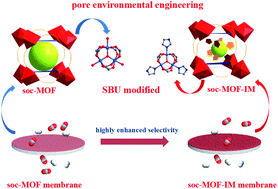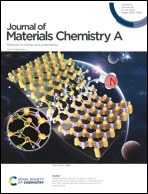Engineering the pore environment of metal–organic framework membranes via modification of the secondary building unit for improved gas separation†
Abstract
The designability and adjustability of the pore structure are vital advantages of metal–organic framework (MOF) materials for separation. Their exploration in the field of membrane separation is still inadequate, especially for the regulation of the pore environment based on the inorganic secondary building unit (SBU). In this work, we have studied the effect of the pore environment regulated by the SBU on the gas separation performance of MOF membranes for the first time. The Fe3(μ3-O)(CH3COO)6 SBU of the parent framework (soc-MOF, a stable microporous Fe-MOF) was in situ modified with imidazole (IM) molecules to construct the soc-MOF-IM polycrystalline membrane. The exact location of the incorporated IM and the narrowed pore size are observed based on the determined crystal structure. The gas solubility, diffusivity and separation performance of the two membranes are evaluated. Compared to the soc-MOF membrane with a H2/CO2 selectivity of 6, the soc-MOF-IM polycrystalline membrane possesses a significantly enhanced H2/CO2 selectivity (48), which is mainly attributed to the triggered molecular sieving effect. Thanks to the facile introduction of functional molecules and precise adjustment of the pore environment, SBU modification can be a powerful strategy to improve the separation performance of MOF membranes.



 Please wait while we load your content...
Please wait while we load your content...